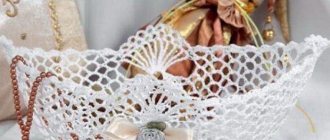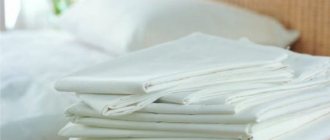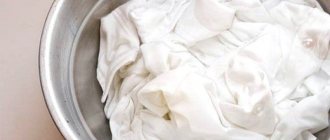Although modern housewives have long since starched almost nothing, sometimes you simply cannot do without it. After all, starched items hold their shape better, and therefore look more elegant and solemn. This is especially true for lush evening or wedding dresses, which consist of several layers. But how to starch a skirt so that it simultaneously holds its shape and looks gentle and feminine? Yes, very simple! You only need to know a few secrets that we will be happy to share with you.
For what?
This method has been used for a long time. It is necessary to give shape to fluffy dresses so that they have a snow-white appearance and do not wrinkle.
Starching allows you to:
- maintain a presentable appearance: the dress wrinkles less;
- look more formal;
- keep your outfit fresh longer;
- emphasize the shape;
- give snow-whiteness;
- highlight small details.
After treating clothes with a solution, a thin film is formed on the fabric, which protects the dress from dirt and dust. A starched outfit will be easier to wash after wearing. Dirt is not absorbed, which makes stain removal much easier.
If a knitted dress is subjected to such processing, the pattern is visible more clearly, and the threads fit more tightly to each other.
Why starch garments?
- The dress will receive a clearer, voluminous shape that will last until the next wash.
- The impression of freshness and presentability will last longer.
- The product will wrinkle less.
- The outlines of the collar and cuffs will remain correct and uncreased due to their rigidity.
A starched knitted dress will look especially impressive. It stretches less, holds its shape, the pattern becomes more prominent, the threads of the knitted fabric lie more evenly. And even the color of the thing seems to become cleaner and brighter.
Where to begin?
Before you starch the dress yourself, you need to inspect it for stains and remove them. Removal of stains is carried out using folk or professional means, for example, Vanish stain remover.
If there is no stain remover in the house, you can use hydrogen peroxide. Apply the product to a clean cloth and wipe the contaminated areas.
This method removes wine, coffee, tea stains and yellow marks from sweat.
After removing the dirt, the dress is washed in a machine to remove dust and get rid of traces that were not noticed. You can also add a capful of 3% hydrogen peroxide to the machine. After this, you can starch the dress for pomp.
First actions
Before starching a skirt or dress, they should be pre-washed or thoroughly cleaned. Otherwise, after starching, things may take on an untidy appearance. This is due to the fact that, along with starch, particles of dust, fluff, and animal hair will be attracted to the material.
After washing, rinse the product, thoroughly removing any remaining detergent. Do not add fabric softener at the end of the rinse.
If yellow spots appear on tulle or other material after long storage, they can be removed with hydrogen peroxide. A few drops of it are applied to the stain and washed off with cool water.
It is advisable to dry your petticoat and other starched items on a balcony with the shutters slightly open or in a ventilated area, but not in direct sunlight.
Types of fixation
There are several types of fixation. The use of the method depends on the preferences of the housewife and depending on what result you want to get.
Table. Types of fixing things:
| Rigidity | Amount of starch per 1 liter of water | What types of fabric is it used for? |
| Soft | 0.5 tsp. | The soft method is suitable for processing dresses made of delicate fabrics, such as chiffon or cambric. |
| Average | 1 tbsp. l. | Medium hardness is used for starching linen or cotton outfits. This method is also suitable for products made of silk, spatula and tulle. The average starching method is used if the dress is openwork or has lace inserts. |
| Tough | 2 tbsp. l. | The hard method is suitable for knitted items. With its help, the shape of the collar and petticoat is also preserved. The hard method is an excellent way to shape dance tutus for ballerinas. |
The process of preparing the solution: the required amount of starch is diluted in 1 liter of warm water. Stir until you get a mass without lumps. You should get a homogeneous solution.
The remaining lumps will negatively affect the final result. If the solution does not work out the first time, it is better to try making a new one.
Purposes of starching
Clothes are starched for the following purposes:
- To give a clear shape to clothes;
- Give freshness so that the item looks like new;
- Minimize the appearance of wrinkles when the material is heavily wrinkled;
- Give clear outlines to small elements - frills, cuffs, collars.
It is important to remember that underwear cannot be starched. Typically the procedure is used for linen, cotton, and tulle. Sometimes a starch solution is used for synthetics, silk, and knitted products. Previously, it was used for collars, bedding sets, aprons, and napkins. Nowadays, starching is usually required for stage outfits and fluffy dresses.
In recent years, full skirts have come into fashion, which should be starched.
Children's clothes for matinees are also often starched. Basically, the petticoats of such products are made of mesh to add volume. If you starch a mesh petticoat, it will keep its shape better.
Processing things in 3 steps
After preparing the solution for starching the dress, it is poured into hot water so that the wedding or children's dress is completely covered with liquid. The product should be warm.
How to properly starch a dress - 3 steps:
- Place the clothes in the solution. Make sure that the paste covers all the material. Straighten out the wrinkles.
- After 30–40 minutes, remove the dress from the solution and inspect for untouched areas. If any are found, place the product in the product for another 15 minutes, spreading it out so that the untouched areas are covered with the solution.
- Now the woman's dress needs to be wrung out. But not too much, so as not to form wrinkles that will be difficult to get rid of.
A child's or adult's dress should not float freely in starchy liquid.
To prevent the fabric from sticking to the iron when ironing, add 3-4 drops of turpentine or 1 tsp to the mixture. salt.
To make the product easier to iron, add 2 tsp to the solution. milk per 1 liter of water.
The starching process is complete. Now you need to smooth the fabric, straighten out folds and creases. Then dry and iron.
If the item is new, it is not necessary to completely immerse it in the paste.
How to starch the petticoat of a child's dress just bought at the store?
To do this, prepare a solution of the required concentration and apply it to the skirts using a sponge. You need to start from the very bottom layer.
For petticoats, a hard solution is used, and the outermost skirt can be left unstarched or made into a soft hard solution, and also treated with a sponge, evenly distributing the product over the entire surface of the item.
The starched product is dried and ironed.
How to starch a tulle skirt
Please note that only the lower layers of the skirt need to be starched; the upper layers should not touch the composition.
The easiest way to starch a tulle skirt at home is by yourself. But there is a small nuance in this process: skirts made of this material consist of many layers. They do not need to be starched completely, otherwise they will turn out to be very large, and this will harm the appearance of the item. Only the lower layers need to be starched; the upper ones should not touch the composition.
Washing machine
If you don’t want to fuss with your wedding dress, you can treat it with a starch solution in the washing machine.
How to starch a dress in an automatic machine - instructions:
- Prepare a solution of the required hardness.
- Starch diluted in water is poured into the conditioner compartment and the desired washing mode is set in accordance with the information on the label.
- You cannot dry it in a machine. Dry the item on a hanger.
- To prevent the washing machine from breaking after such a procedure, it must be run idle. This way, the remaining starch particles will be removed along with the water during spinning.
- Then wipe the drum with a dry cloth.
The dress is ready for further processing. This process does not take much time and does not require monitoring the procedure.
When machine washed, the product is processed evenly. There are no unstarched areas left.
Make a child's dress more elegant
With a festive children's dress, do the same as with a wedding dress. That is, petticoats are starched and then ironed. Such dresses are usually decorated with small details: ruffles, flounces, frills, which after washing look drooping and wrinkled. They should also be starched and ironed with a small iron.
We recommend: How to glue rhinestone patterns onto fabric or nails and what glue is best to use?
Drying rules
In order for a starched dress to acquire the desired shape, it must be properly straightened. The creases formed after drying will not be easy to smooth out.
The product is hung on hangers and each fold is thoroughly straightened. If this is not done, the product will not dry correctly.
Drying the starched product is carried out at room temperature. It should be kept away from radiators and other heating devices. You also can’t take it out into the cold. Very low temperatures can damage starch-treated material.
If the result is satisfactory, then the product will need to be starched every time it is washed. But only individual areas will have to be processed, and not the entire surface.
Preparing the petticoat for starching
It’s not just that ballerinas’ tutus keep their shape for a long time. Costumers carefully prepare for processing the product. Preparation consists of the following steps:
- Wash the petticoat so that no stains remain;
- When washing, rinse thoroughly to ensure there are no powder residues. Otherwise, streaks will form on the product;
- Inspect the item to ensure there are no lumps of dirt left on it. Once they harden in starch, they will be difficult to remove.
Important: There is no need to use conditioner. It makes the product soft, but the opposite result is required.
How to replace homemade paste?
Not everyone can prepare a paste from starch at home. Even a woman experienced in this matter is not always able to prepare a solution without lumps.
Therefore, various means for starching were invented. You can buy liquid, powder or spray in supermarkets to make the job easier.
Spray is the most convenient remedy. It is evenly applied to the material. The spray is great if you need to treat individual areas. For example, a bow, a frill, a frill, a cuff. The spray is simply sprayed onto the desired area during the ironing process.
It is better to treat the petticoats of a wedding, ball or children's dress with powder or liquid starch. Such products are used for washing in a machine; they are added to the compartment for powder or conditioner after the main washing cycle has been completed.
Making a solution
To make it yourself, buy potato starch. Corn or rice, by the way, are also suitable.
Before you starch your skirt, decide how stiff you want it to be. If, for example, you only need to slightly “strengthen” your petticoat, 5 g of starch per liter of water will be enough. If this detail of the outfit will support several heavy skirts, prepare a more concentrated solution:
- Boil 500 ml of water.
- Dissolve a tablespoon of starch in a glass (200 ml) of cool water. Stir thoroughly until lumps disappear.
- Pour the starch into boiled water, keep the solution on the fire with constant stirring for about 5 minutes, until transparent.
- Strain the liquid through cheesecloth to remove any lumps.
Starch a satin skirt
Adding 1/2 teaspoon of salt to the starch solution will give the skirt a glossy shine.
Satin clothes are the most difficult to starch due to the density of the material. We prepare the solution from 2 tablespoons of starch and a glass of water, then dilute the composition in a liter of boiling water. Pour the resulting mixture into a bowl of water at room temperature and completely lower the skirt there. It should lie in the starch for 15–20 minutes.
After the procedure, dry the item on a hanger, then iron it with an iron and steam.
All things can be starched; they become more durable and less susceptible to contamination. If you use our grandmothers' secret and add 1/2 teaspoon of salt to the solution, you can give things a glossy shine.











